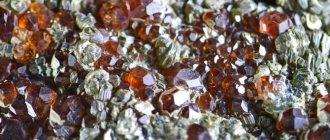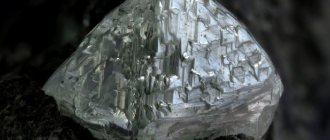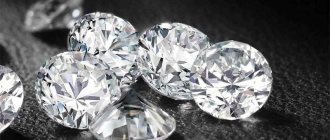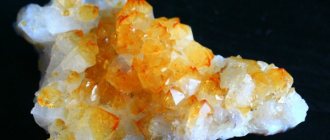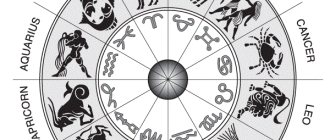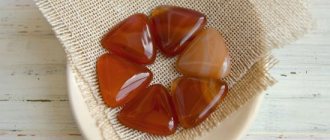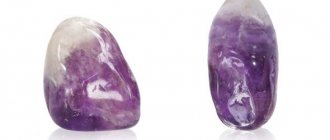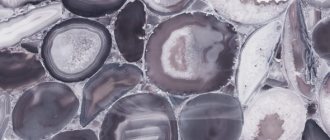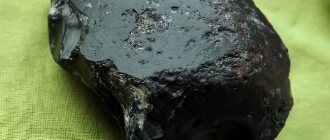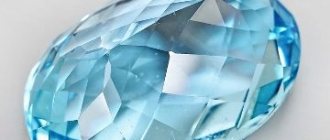The most beautiful of minerals, tanzanite is too young to boast of ancient legends or myths. There are no great historical events associated with it, no special magical rituals were performed. However, this exceptional natural talent is endowed with incredible beauty, healing and magical properties.
The attractive power of the gem once conquered the cinema, displacing the expensive gemstone.
Origin story
It all started in the summer of 1967. The Portuguese Manuel De Souzo went on an expedition to Tanzania to look for precious rubies. The Maasai, one of the largest tribes of indigenous people, helped and accompanied the discoverer.
A few weeks later, tired of long fruitless searches, the expedition discovered deposits of large crimson-violet crystals. This happened in the province of Arusha, at the foot of Mount Kilimanjaro. Stone deposits formed in cracks where changes occurred under the influence of rock pressure and high temperatures.
Initially, the find was mistaken for Sapphires, but the mineral turned out to be much softer. A little later, research showed that the find was a variety of Cyosite, a fairly well-known and widespread mineral that was not used in the jewelry industry.
A rare, precious nugget risked remaining unnoticed and unknown. But already in 1968, the stone attracted the attention of Henry Plath, vice president of the American jewelry house Tiffany, who named the gem tanzanite, in honor of the mineral deposit.
This is interesting: The world's largest cut tanzanite, weighing 242 carats, belongs to Michael Scott, the first executive director of Apple. This stone appears in the tiara called “Queen of Kilimanjaro”.
The Smithsonian Research Institution in the United States also holds a cut specimen of tanzanite that weighs 122.7 carats.
Since that time, despite the difficulty of processing, tanzanite has been used to make expensive, exclusive jewelry. One version says that the famous “Heart of the Ocean” pendant from the film “Titanic” used an insert made of tanzanite, which looked brighter and more attractive than the bluest sapphire.
Tanzanite deposits
The only place on Earth where the mineral tanzanite is mined is the Merelani plateau at the foot of Mount Kilimanjaro. All deposits fit on an area about five kilometers long. Blue cyosite crystals grow in clusters in gorges and rocky crevices.
60% of stone mining is concentrated in Tanzania.
In addition to Tanzania itself, the mineral is being developed by Great Britain and the Republic of South Africa. However, it is Tanzania that controls 60% of gem exports. For convenience, the plateau is divided into four sections. They are designated by the letters A, B, C and D respectively. These areas have different management companies and conditions.
Place of Birth
One of the reasons for the high cost of the stone is its rarity and inaccessibility. From the moment of discovery until today, one single deposit is known, in fact, the birthplace of the mineral is Tanzania, Arusha province, which is located southwest of Mount Kilimanjaro, at a distance of 60 km.
The field, called Merelani, has been divided into four blocks since 1990. Each block is developed by different mining companies. Since 2004, 60% of all mineral reserves have been mined in one of four blocks by the Tanzanian company Tanzanite One Group.
Products and jewelry made of tanzanite
Tanzanite stone ring
Finding real tanzanite in mass sale is almost impossible. Jewelry with it is sold only by large and well-known jewelry houses, such as Tiffany, Sokolov and others. On their counters there is a fairly wide selection of jewelry with an insert of blue gems - these include rings, earrings, bracelets, and necklaces.
Prices are always high; you will have to pay a lot for endless blue in a gold frame, for example:
- For earrings – 200-1300 dollars.
- For rings – 190-1300 dollars.
- For a pendant - 200-600 dollars.
- For a bracelet (usually with one stone) – about $1000.
Tanzanite earrings
Tanzanites are extremely rarely set in silver. Such jewelry can only be purchased from the authors, but they will also be quite expensive:
- Figured ring with 3 small stones – $75-100.
- Openwork set of ring and earrings with nanostones – $130.
Such jewelry usually uses lower quality, lighter stones or their crumbs.
Physical properties
One of the interesting properties of tanzanite is optical pleochroism - the stone is able to change color depending on the viewing angle. Some specimens may exhibit an alexandrite effect. This means that the mineral appears blue in daylight, but changes color to purple in artificial light. There are also rare specimens with a cat's eye effect.
Tanzanite is transparent and has a glassy sheen. This is a soft and fragile mineral, so not all jewelers undertake its processing. When cutting a mineral, craftsmen try to enhance its natural blue color. Those samples that nature has not endowed with a deep sapphire color can be heated to 500°C - under the influence of temperature, all accompanying shades disappear, and the blue becomes more saturated.
| Property | Description |
| Formula | Ca2Al3(SiO4)(Si2O7)O(OH) |
| Hardness | 6,5 — 7 |
| Density | 3.35 g/cm³ |
| Refractive index | 1,691 — 1,700 |
| Kink | Uneven. |
| Fragility | Fragile. |
| Cleavage | Perfect. |
| singonia | Rhombic. |
| Shine | Glass. |
| Transparency | Transparent. |
| Color | Sapphire blue to amethyst purple. |
Pricing Features
Tanzanite is a rare and quite expensive gemstone. Its price reaches the level of the cost of sapphires, but, as a rule, does not exceed it. In the jewelry market over the past few years, the price of a gem has stopped at around $300 for 1 carat of a stone that has already been cut.
- Instances of a natural blue, violet-blue hue are much more expensive than those that have already undergone heat treatment. Tanzanite is a polychrome stone and can include many shades that are only visible from certain angles and lighting. Particularly valued are minerals that have not been exposed to high temperatures and have a multi-colored color that comes from nature. Polychrome tanzanites look especially beautiful in fine jewelry, the price of which can amaze even experienced collectors.
- Valuable ultramarine or sapphire stones are often mined in the upper layers of the soil. They acquired a rich hue under the influence of sunlight and burning lava. It is believed that the richest colors can be seen in large stones.
- Separately, we need to consider the question of how much a mineral with visible color transitions – pleochroism – costs. There are also gems with a “cat’s eye” effect. Jewelers like to work with this material and their works have fairly high price tags.
- Tanzanite with alexandrite effect is also a welcome guest on the jeweler's table. The essence of this property is that the ultramarine mineral turns purple when placed under artificial lighting.
- Experts also evaluate the shine of the stone. Expensive, high-quality tanzanite has ideal transparency, and its edges have a mother-of-pearl line.
- Not all craftsmen like to work with soft tanzanites. Such material is expensive and fragile; just one wrong move can ruin a valuable specimen. To give the stone the desired blue color, it is exposed to high temperatures. Tanzanite is heated to 500 degrees. Thanks to this, the blue color begins to actively manifest itself.
Sellers do not always tell the buyer that the jewelry acquired an attractive shade after heat treatment. This fact will reduce the price, which no one wants to allow. Experts say that 95% of mined stones have “inappropriate” shades and turn blue after processing.
Healing properties
Tanzanite is endowed with more than just natural beauty. The nugget has remarkable medicinal properties in its arsenal:
- Effect on visual acuity. Contemplating tanzanite will help improve your vision. The mineral is recommended to be used to relieve eye strain during long periods of work at the monitor or any activity that leads to eye fatigue.
- Headache. When contemplating the stone, the nervous system relaxes, which helps overcome migraine attacks.
- Prevention of colds. Traditional healers claim that owners of the mineral are less susceptible to flu or colds than others, since regularly wearing the gem strengthens the human immune system.
- Pain in the spine. Tanzanite will become an assistant for people engaged in sedentary work - the mineral will relieve them of pain in any of the spinal regions.
- Skin diseases. With skin-to-skin contact, the gem relieves the owner of any skin diseases, including teenage rashes and acne.
It should be noted that only natural minerals are endowed with healing powers. The fake will only be a decoration for the owner.
Medicinal properties
The main healing property attributed to the stone is its ability to gradually restore lost visual acuity. The effect helps those who see worse due to constant work at the computer or with small details. If you regularly admire the jewelry and peer into the transparent tanzanite stones, the tension in your eyes will go away.
Purple tanzanite
The relaxing property helps owners of the mineral fight constant headaches and migraines. To do this, you need to often wear earrings with a gem for preventive purposes, or at least put them on during attacks. But bracelets with semi-precious tanzanite stone will save you from back pain.
The therapeutic effects of the nugget promise to get the owner back on his feet faster after a cold and relieve fever.
The mineral is believed to strengthen the immune system and help the body fight viruses. Anyone who carries it with them constantly gets sick less often and experiences acute respiratory viral infections and acute respiratory infections much easier.
Tanzanite jewelry in the form of a pendant or necklace can speed up the treatment of cosmetic blemishes on the face, such as acne or blackheads. For the same purpose, it is recommended to wash your face with water in which a bright crystal has been kept for some time. A ring with tanzanite in gold will relieve skin problems on the body. It will also help you relax after a hard day and improve your sleep.
Magical properties of the mineral
The mineral has gained fame as a family stone, as well as a talisman of wealth and luxury. It is believed that the gem helps the owner discover new facets in himself, find meaning and purpose in life. The mineral will also help to cope with a difficult life situation when a person is at a crossroads. He only has to ask the talisman for help - the right decision will automatically come to the owner.
The magic of tanzanite dissipates in several directions:
- The mineral acts as a faithful companion to psychics, as it is able to reveal and strengthen the gift of clairvoyance. People who are not endowed by nature with extrasensory abilities will be able to develop a sense of intuition with the help of tanzanite.
- The gem creates a calm atmosphere around the wearer. Thanks to this magical property, the owner of the mineral rarely becomes a participant in conflict situations, and all disagreements are resolved peacefully. For the hearth and home, the amulet will preserve comfort, protect against intrigue at work, and also unite a friendly company.
- Despite its natural fragility, the gem is a symbol of a strong family and marital fidelity. In case of betrayal of one of the spouses, the talisman will send bad luck to the person in all matters, which will haunt the traitor until he settles down. For single people, the gem helps them meet their soul mate, but if a person has just an affair on his mind, and not starting a family, the stone is not a help to him.
- The mineral is famous as a talisman of the rich, as it is able to attract a flow of monetary resources to a person. But this does not mean that the talisman will help you win a million dollars in the lottery. Tanzanite does not tolerate lazy, uninitiated people. The stone favors only purposeful, hard-working individuals.
This is interesting: There is a belief that tanzanite is ideal as a gift for a married couple for a silver wedding, which is considered the middle of family relationships. The mineral will help the spouses live as many more years in love and harmony, filling their home with the necessary energy.
In addition, the mineral patronizes people who are faced with choosing a type of activity. The stone concentrates a person’s attention on those talents that will help the owner get maximum profit, pleasure, and self-realization from work. For creative individuals, the mineral brings inspiration, an endless flight of imagination to create new masterpieces of art.
Talismans and amulets
People seeking to find happiness, prosperity and success in life can safely turn to tanzanite for help. A talisman can be either jewelry (earrings, pendants, rings), or just a pebble with or without a frame.
Adding a brooch with a mineral to your look every day will certainly contribute to your career growth. A ring with a gem will help you find true love and create a strong marriage. Earrings with tanzanite will help the owner become more feminine, more attractive in the eyes of the stronger sex, and will give the woman confidence and charm.
Fakes
Tanzanite is easily distinguished by pleochroism, that is, the change in shades when the stone is rotated. The color of the stone should be natural and not poisonous.
When immersed in water, a light stripe can be seen at the edges of the stone.
A glass fake can be easily identified by its significantly lower shine and refraction of light rays. In addition, a fake can be recognized by running a stone across the glass. Natural tanzanite will leave a scratch, but fake tanzanite will not.
When fired, the stone becomes clear of inclusions and defects. Carefully examine the gem under a magnifying glass.
You can distinguish tanzanite from a fake by price. Prices for large stones start at $2,000 per carat.
Other precious stones, for example, sapphire, can be passed off as this rare stone. Only an experienced jeweler can distinguish them from tanzanite.
The worst thing is to buy a glass fake covered with thin slices of tanzanite. In this case, pleochroism is observed, but the stone will quickly come apart. You can distinguish a fake only by examining the stone under a magnifying glass.
A distinctive feature of this unique gem is trichroism. When the gemstone is rotated, the color changes from blue to purple, and at certain angles yellow-brown or greenish-yellow tones appear. Unfortunately, these iridescences of tanzanite colors cannot be seen in the photo, so in doubtful cases, contact experienced experts.
Compatibility with other minerals
Tanzanite is a naturally beautiful, bright gem that does not need the proximity of other minerals. The stone is self-sufficient, so other gems spoil it, diverting attention to themselves. The only successful combination is tanzanite with diamonds, which will emphasize the meaning and luxury of the mineral.
From the point of view of a magical tandem, a combination of tanzanite with citrine or amethyst is acceptable - this will help in the search for love.
Any career heights can be achieved by a person who combines the mineral with topaz. For girls, purple tanzanite will be a successful match. With the help of this couple, the young lady will achieve success in love and career.
Historical reference
Tanzanite is a unique stone, because it can be called our “contemporary”. Unlike emeralds, rubies and a number of other jewelry that were discovered several thousand years ago, this unique specimen appeared before people only in 1967. The first to see something in the inconspicuous gray pebble was Manuel De Souza, a Portuguese who in the summer went to Tanzania to look for rubies in the company of Maasai hunters.
The hunters spent a couple of weeks searching for the jewelry and were rewarded for their perseverance. Near Kilimanjaro they found interesting purple stones. At first the men thought that they were seeing sapphires. Already in the course of further research, scientists established that this was a new mineral, which differed not only in color, but also in physical properties and softness.
Today this unique stone is known all over the world, but few people realize that it got its name thanks to the legendary Tiffany brand. Representatives of this jewelry company proposed to name the gem in honor of the place where it was found.
Jewelry with stone
A nugget from a distant African country is very difficult to process due to its natural softness and fragility. Few jewelers decide to work with it, since the price of mineral crystals is high, and the time wasted in case of failure is priceless. Still, those masters who are up to the task create magnificent jewelry masterpieces.
Naturally, the buyer will not find jewelry with tanzanite on market stalls or boutiques selling costume jewelry. Such jewelry is sold only by elite jewelry houses. This semi-precious stone is framed in precious metals, so the cost of a product with natural stone is high:
- a handmade gold ring with inserts of natural tanzanite and small diamonds can cost the owner 7,000–8,000 thousand rubles;
- earrings can be found for 30,000 rubles and more, depending on the metal, the weight of the stone and other inserts;
- a gold pendant with collectible tanzanite will cost approximately 75,000 rubles.
Of course, you can find jewelry with more modest prices. The main thing is that the seller has a certificate confirming the authenticity of the mineral. Otherwise, you risk purchasing a fake.
Application and care
The African gem is very soft and fragile, so not every jeweler will decide to work with it. It is very difficult to process the mineral, the raw materials are expensive, and in case of defects, no one will compensate for the money spent. However, craftsmen who are able to cope with this difficult task create luxury jewelry with tanzanite, which often costs a fortune.
Tanzanite is difficult to process, which is why it is quite rare and expensive.
Except in jewelry, the gem is not used anywhere. It is too rare and beautiful to be an ornamental material or used in industry. Tanzanite is most often used to make rings, bracelets, studs and pendants.
It is impossible to find treasured items with tanzanite on market stalls; you shouldn’t even try. Only the best jewelry houses sell this gem. The crystal is most often set in platinum or gold, so the cost of such jewelry is very high.
In order for a rare and expensive stone to serve you as long as possible, you should follow several rules for wearing it.
- Tanzanite does not tolerate temperature fluctuations, so you should not wear it in winter or when going to the sauna.
- It is best to wear jewelry with the stone after you have applied makeup to reduce the chance of harsh chemicals coming into contact with the stone. It also does not tolerate acidic environments.
- The gem is afraid of high humidity, so it is recommended to remove it when going to the bathroom or shower.
- It is advisable to wash tanzanite with a weak solution of baby soap. Abrasive and detergent substances can damage the stone beyond repair. After cleaning, the gem should be carefully wiped with a soft suede cloth.
- Mechanical damage, even minor, can be fatal. It's best not to drop the stone and be careful with hard surfaces. It is also best to store the gem separately from other crystals, wrapped in a soft cloth.
Color variety of the mineral
Tanzanites mined from the depths of the earth most often have a brown or brown tint. To give a deep blue color, stones can be heat treated. Minerals that are found on the surface are already endowed with an unusual blue-violet color, as they were exposed to natural temperatures.
All mined specimens are divided into two types. In some, blue predominates, in others, purple. The relationship to one or another species determines the amount of chromium and vanadium in the chemical composition of the mineral.
Nature also presents small samples of pink and lavender shades, and sometimes completely transparent. There are large green crystals. Often there is a combination of several colors in one nugget.
Varieties and colors
Most often, tanzanite is found in the form of unremarkable brown-brown nuggets. They are not used in jewelry in their original form, but are first subjected to an annealing procedure. Heating the stone to 400–650 °C allows you to remove unwanted inclusions, emphasize the deep sapphire color, or completely discolor the crystal.
All found specimens of the gem are divided into 2 large groups: with a predominance of purple or blue. One of the varieties of the stone is the concentration of vanadium and chromium ions. The content of compounds is responsible for the final leading shade.
But this does not mean that the color of the stone is limited to only the above two.
In nature, large minerals of green, violet, sapphire colors are found, less often - small pink, lavender and transparent. Often most of the shades are combined in one nugget. Tanzanite is characterized by pleochroism - its color changes depending on the viewing angle and lighting.
How to distinguish natural stone from fake?
No one has yet succeeded in making artificial tanzanite with the properties of natural stone. However, there are plenty of synthetic fakes, so it’s worth knowing a few tips that will help you avoid falling for scammers:
- Testing for pleochroism. The natural mineral changes hue at different viewing angles, in daylight or lamp lighting. Linden stones made from forsterite glow when exposed to ultraviolet rays. This glow is not characteristic of natural tanzanite.
- Colors. Poisonously bright, unnatural shades are a sign of a fake.
- Exposure to water. Immerse the jewelry in water - natural tanzanite will become lighter at the edges, but the fake tanzanite will not change color.
- Price. Real mineral is expensive. The only thing you can find cheaply is glass.
- Purity of shade. In jewelry, pure crystals are used that are free of any impurities through heat treatment.
The height of the art of fraud allows you to deceive the buyer by coating ordinary glass with a thin layer of tanzanite. In this case, it is impossible for an ordinary person to distinguish a fake, since formally the analogue has all the signs of a natural mineral. Therefore, it is better to make such an expensive purchase in a trusted place.
Colors and types
We know tansatite as a stone with a blue or purple hue, but in nature it looks different. In its original form it is green or brown in color. The mineral changes color when exposed to high temperatures.
To add color artificially, special ovens are used that heat up to 600 °C. If we are talking about natural coloring, then this occurs under the influence of either strong radiation or hot lava.
The color and type of treatment have a direct impact on the price of the stone. Thus, naturally colored minerals will cost many times more than their “artificial” counterparts. The method of origin of tanzanite does not affect its properties in any way.
How to wear it correctly?
Tanzanite jewelry is worn extremely rarely and is worn very carefully. Products with minerals are always luxurious, so the outfit, as well as the event, must be appropriate.
Elite jewelry will not suit casual or sports clothing. The stone looks best with a glamorous or romantic look. If classic style prevails in everyday clothes, then modest earrings with a mineral will perfectly complement the look.
An important aspect is the selection of shoes and other accessories. Tanzanite does not like unnecessary proximity, since any flashy item or decoration will overshadow the luxury of the gem. In shoes, it is better to give preference to high heels.
The mineral will adorn a woman of any appearance, regardless of hair or eye color. However, tanzanite is more suitable for those with gray and blue eyes.
When choosing makeup, you should also adhere to minimalism. Light, everyday make-up is most appropriate. If you are going to a party, smoky ice is a good solution. It is better to put off bright lipstick and replace it with lip gloss.
Who suits the name
Tanzanite stone is suitable for extraordinary, interesting and symbolic names. This connection is due to the unique occurrence of rocks with a mineral and a wide range of properties. We combine the gem with the following female names:
- Ariel.
- Alice.
- Glafira.
- Vasilisa.
- Violet.
- Annetta.
- Rosalia.
- Jasmine.
- Aurora, etc.
Male names:
- Plato.
- Augustine.
- Robert.
- Adam.
- Albert.
- Arnold.
- David, etc.
Product care
Some care recommendations will help preserve the original appearance of your expensive jewelry:
- jewelry should be stored in separate boxes, having previously placed each one in a bag made of velvet fabric;
- It is prohibited for the stone to come into contact with sharp objects;
- The mineral should be cleaned only when absolutely necessary, using warm water and mild detergents;
- It is undesirable to expose the gem to toxic chemicals, steam, or ultrasonic waves.
A little thrift will preserve the unsurpassed beauty of tanzanite.
What stones does it go with?
When creating jewelry, craftsmen take into account the combination of the main jewelry with other stones. Tanzanite is a very self-sufficient and strong mineral. No other gem can compete with it in strength, beauty and brilliance. If there are two bright minerals in a piece of jewelry, the overall appearance of the piece is spoiled, it looks strange and even cheap, which is why jewelers prefer to make tanzanite the main star of the accessory.
To highlight the brilliance of precious facets, craftsmen choose diamonds for their shimmer. It is very rare to find a duet of tanzanite with amethyst or topaz, and even less often ruby is added to it. The gem can be framed in silver, gold, platinum, photos of finished products.
Compatibility with zodiac signs and names
Astrologers continue to argue about which zodiac signs the mineral is suitable for. Some are inclined to believe that the stone suits the elements of Fire, others talk about the elements of Water and Air. The only conclusion is that the gem will not harm any of the zodiac signs. Tanzanite can strengthen or weaken the character traits of a certain person.
(“+++” – the stone fits perfectly, “+” – can be worn, “-” – is strictly contraindicated):
| Zodiac sign | Compatibility |
| Aries | +++ |
| Taurus | + |
| Twins | + |
| Cancer | ++ |
| a lion | + |
| Virgo | + |
| Scales | + |
| Scorpion | + |
| Sagittarius | + |
| Capricorn | ++ |
| Aquarius | ++ |
| Fish | ++ |
Most astrologers believe that the stone is protected by the planet Saturn. This makes it a suitable talisman for representatives of the water element - Aquarius, Pisces, Cancer and Capricorn. The mineral has ideal compatibility with Aries - the gem imparts calmness, balance and wisdom to the naturally hot-tempered representatives of this sign.
Tanzanite is the patron stone of the name Galina. A gem decorating a ring will help you concentrate the attention of others and achieve universal love. For Galin, protection from bad looks, which the tanzanite amulet will give her, is important. A mineral placed under the pillow will protect against bad dreams.
Stones from the evil eye and damage (video)
But if a woman does not strive for a serious relationship and changes men like gloves, the African stone may become angry with her and take away everything that he gave her before.
When choosing an amulet, you should take into account that tanzanite has different effects on representatives of individual zodiac signs. For temperamental and impatient Aries, the gem will help control their emotions, give them wisdom, calmness and prudence. For people whose zodiac sign is Cancer, Scorpio or Pisces, the mineral will give them confidence in their own abilities and protect them from failures. Tanzanite is selective towards representatives of other signs. If a person treats the mineral with respect, he will soon feel its beneficial effects. If the owner does not surround the stone with the necessary love, it will refuse to help him.
Note
Tanzanite is a fragile creation of nature. Only one place on Earth can boast of this talent. According to scientists, the supply of the mineral will be exhausted. The most optimistic forecasts give hope for production for a maximum of another 20 years. And then this stone will become priceless.
Nature has endowed the nugget with unusual properties, as well as friendliness towards humans. Only the thrift of future generations will help preserve this miracle of nature for many centuries.
4.2 / 5 ( 12 votes)
Talismans and amulets
Earrings with tanzanites
History has not preserved evidence of the use of tanzanite in ancient times as talismans and amulets. However, modern esotericists are confident in the stone’s ability to improve the life of its owner.
They believe that tanzanite is needed:
- For married couples to strengthen marriage bonds, maintain fidelity and improve the well-being of the family.
- To all representatives of the fair sex to increase their attractiveness and enhance their “feminine charms”.
- For young people free from relationships to find a soul mate, and for established couples to move to a new level - concluding a marriage or, conversely, breaking a painful relationship.
- For creative individuals to “connect” to an inexhaustible source of inspiration and discover new talents.
- For those who are undecided in life to find their own purpose. And also for those who are at a crossroads and don’t know what to do. If you ask tanzanite for advice, the solution will come naturally.
- Absolutely everything to improve your financial situation.
Attention!
Tanzanite does not tolerate betrayal and betrayal. He can even punish the traitor - send him illnesses, losses and failures.
Tanzanite also does not tolerate lazy people. Purchasing a talisman does not guarantee that wealth will fall from heaven to the thirsty. However, if a person strives for a goal and makes every effort, then the stone will help him. All human attempts will be crowned with success, and money will flow like a river.
As for the compatibility of the blue gem with names, there are no restrictions. The only ones who are singled out by the stone are the Galinas. It gives them comprehensive protection, helps them win everyone’s attention and respect, and also helps them avoid making mistakes in choosing a life partner.
How to care for stone
Tanzanite stone
Although tanzanite has a good hardness on the Mohs scale (6.5-7), among mineralogists it is considered a soft mineral, since it is easily divided into plates and can even crumble from the wrong sudden movement.
The stone is fragile, it must be treated with care, and every owner should know this.
Caring for tanzanite involves following the following rules:
- Jewelry with stones should not be dropped or hit, or subjected to strong friction.
- Such products should be stored separately from other jewelry in a personal case with soft walls.
- Overheating, temperature changes, being in an acidic environment and excessive humidity have a detrimental effect on the stone, that is, you should not take tanzanite with you to a bathhouse or sauna, or wear it while cleaning, washing or doing other housework.
- You should wear jewelry with the “blue beauty” only after makeup and perfume have been applied, in order to avoid accidental contact of these products with the stone.
- Tanzanite is cleaned as rarely as possible, for which it is quickly and “gently”, that is, without the use of aggressive chemicals and abrasives, washed and wiped dry with a suede cloth. For severe stains, it is permissible to use a small amount of baby soap.
